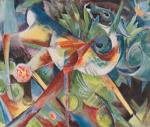Marc, "Reh im Blumengarten".
“Reh im Blumengarten”.
Original Art-Print from the 1960s or 1970s, reframed from its original Frame with the original back of the old frame stating “Kunsthandlung O. Hofstätter”. Germany, c.1970. Print-Size: 36 cm wide x 32 cm high. Framed: 51 cm x 51 cm. Excellent condition. High Quality Artprint of the late 1960s or early 1970s. Franz Marc’s Masterpiece in a beautiful modern frame. The price includes international free shipping per UPS Courier.
Franz Moritz Wilhelm Marc (8 February 1880 – 4 March 1916) was a German painter and printmaker, one of the key figures of German Expressionism. He was a founding member of “Der Blaue Reiter” (The Blue Rider), a journal whose name later became synonymous with the circle of artists collaborating in it.
His mature works mostly depict animals, and are known for bright colouration. He was drafted to serve in the German Army at the beginning of World War I, and died two years later at the Battle of Verdun.
In the 1930s, the Nazis named him a degenerate artist as part of their suppression of modern art. However, most of his work survived World War II, securing his legacy. His work is now exhibited in many eminent galleries and museums. When up for auction, his major paintings attract large sums, with a record of £12,340,500 ($24,376,190) for Weidende Pferde III (Grazing Horses III).
Franz Marc was born in 1880 in Munich, the then capital of the Kingdom of Bavaria. His father, Wilhelm Marc, was a professional landscape painter; his mother, Sophie, was a homemaker and a devout, socially liberal Calvinist. At the age of 17 Marc wanted to study theology, as his older brother Paul had. Two years later, however, he enrolled in the arts program of Munich University. He was first required to serve in the military for a year, after which, in 1900, he began studies instead at the Academy of Fine Arts, Munich, where his teachers included Gabriel von Hackl and Wilhelm von Diez. In 1903 and 1907, he spent time in France, particularly in Paris, visiting the museums in the city and copying many paintings, a traditional way for artists to study and develop technique. In Paris, Marc frequented artistic circles, meeting numerous artists and the actress Sarah Bernhardt. He discovered a strong affinity for the work of painter Vincent van Gogh. After the 1903 trip, he ceased attending the Academy of Fine Arts.
During his 20s, Marc was involved in a number of stormy relationships, including an affair lasting for many years with Annette Von Eckardt, a married antique dealer nine years his senior. He married twice, first to Marie Schnür, then to Maria Franck; both were artists. In 1906, Marc traveled with his elder brother Paul, a Byzantine expert, to Thessaloniki, Mount Athos, and various other Greek locations. A few years later, in 1910, Marc developed an important friendship with the artist August Macke. In 1910 Marc painted Nude with Cat and Grazing Horses, and showed works in the second exhibition of the Neue Künstlervereinigung (New Artists’ Association, of which Marc was briefly a member) at the Thannhauser Galleries in Munich.
In 1911, Marc founded the Der Blaue Reiter journal, which became the center of an artist circle, along with Macke, Wassily Kandinsky, and others who had decided to split off from the Neue Künstlervereinigung movement. Though Marc showed several of his works in the first Der Blaue Reiter exhibition at the Thannhauser Galleries in Munich between December 1911 and January 1912, as it was the apex of the German expressionist movement, the exhibit also showed in Berlin, Cologne, Hagen, and Frankfurt. In 1912, Marc met Robert Delaunay, whose use of color and the futurist method was a major influence on Marc’s work; fascinated by futurism and cubism, Marc created art that increasingly was stark in nature, painting natural abstract forms which found spiritual value in color. He painted The Tiger and Red Deer in 1912 and The Tower of Blue Horses, The Foxes, and Fate of the Animals in 1913.
With the outbreak of World War I in 1914, Marc was drafted into the Imperial German Army as a cavalryman. By February 1916, as shown in a letter to his wife, he had gravitated to military camouflage. His technique for hiding artillery from aerial observation was to paint canvas covers in broadly pointillist style. He took pleasure in creating a series of nine such tarpaulin covers in styles varying “from Manet to Kandinsky”, suspecting that the latter could be the most effective against aircraft flying at 2,000 metres (6,600 ft) or higher.
After mobilization of the German Army, the government identified notable artists to be withdrawn from combat for their own safety. Marc was on the list but was struck in the head and killed instantly by a shell splinter during the Battle of Verdun in 1916 before orders for reassignment could reach him.
- Keywords: Art – Rare · Blauer Reiter · Catalogue Four – International Art · Der Blaue Reiter · Expressionism · Expressionismus · Franz Marc · Inanna Modern – Decorative Art · Inanna Modern – Modern Decorative Art (1870 – 1970) · Modern Art · West Cork Rare Book Fair 2022
- Inventory Number: 100120AG
EUR 680,--
© 2025 Inanna Rare Books Ltd. | Powered by HESCOM-Software










